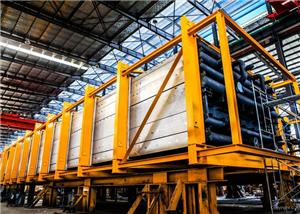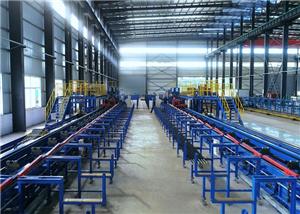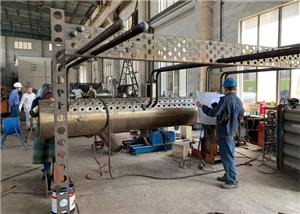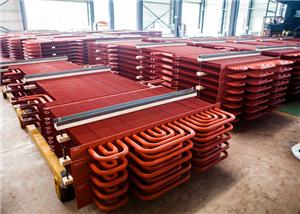-
1.Apakah Jenis Panas Sisa yang Dipulihkan dari Dandang Panas Sisa
The principle of waste heat boiler is that the fuel oil, gas and coal are burned to produce the heat emission of high-temperature flue gas. The high-temperature flue gas first enters the furnace chamber, then enters the waste heat recovery device of the front smoke box, then enters the pyrotechnics pipe, and finally enters the waste heat recovery device of the flue pipe of the back smoke box. The high-temperature flue gas turns into low-temperature flue gas and is discharged into the atmosphere through the stack. 1. High temperature flue gas waste heat: it is a common form, its characteristics are large output, concentrated production point, strong continuity, easy to recover and use, heat absorb accounted for 40~50% of the total heat, the waste heat boiler recovery heat, can be used in production or daily life heat and power generation. 2. Residual heat from high temperature furnace slag, 3. High temperature product waste heat: such as steel billet, high temperature forging part etc, 4. The residual heat of combustible waste gas and liquid waste, 5. Residual heat of chemical reaction, 6. Residual heat of cooling medium, 7. Waste heat from condensation water.
-
2.Mengapa HRSG Menggunakan Tiub Bersirip?
Sebab mengapa tabung bersirip digunakan dalam HRSG: untuk meningkatkan kecekapan dandang haba sisa, perbezaan suhu antara suhu asap dan suhu wap dandang mesti dikurangkan. Terdapat percanggahan perbezaan kawasan, rintangan dan suhu. Kawasan pemanasan dandang haba sisa akan ditingkatkan. Untuk mengurangkan kehilangan rintangan aliran, kawasan aliran dapat ditingkatkan dan kelajuan aliran dapat dikurangkan. Walau bagaimanapun, aliran kelajuan rendah pasti mengurangkan kecekapan pemindahan haba; Untuk meningkatkan kawasan pemindahan haba; Sebaliknya, kawasan HRSG akan meningkat hingga tak terhingga; Penggunaan tiub berputar spiral dapat memastikan kawasan pemindahan haba yang mencukupi, meningkatkan pemindahan haba, dan dapat mengurangkan ketahanan gas serombong!
-
3.Petua Dandang
1. The drum is connected by a riser and a downcomer to form a natural circulation loop.Upper drum is filled with water and steam mixture from circulation loop,normally there will be water steam seperating device and feeding water distribution pipe.In order to improve the quality of boiler water some boilers are also equipped with continuous sewage pipe and dosing pipe. There is a regular sewage discharge device in the lower drum. On the outer wall of the upper boiler drum of steam boiler, there are also flanged short pipes connecting the main steam pipe and the secondary steam pipe and flanges and short pipes connecting the continuous water level gauge, pressure gauge, safety valve and other accessories. There is a regular blowdown device for discharging sediment in the lower boiler drum. 2. For larger capacity boilers, simply using natural separation of steam and water can no longer meet the requirements, need to install a seperating device inside upper drum. 3. The water-cooled wall tube is usually a no.10 or no.20 seamless steel tube with an outer diameter of 51~76mm and a wall thickness of 3.5~6.0mm. The distance between the center of the tube is generally 1.25~2 times of the outer diameter of the tube.Both finned tubes and bare tubes. 4. Water - cooled walls are generally fixed on the upper, the lower can be free expansion. 5. The function of steam superheater is to heat the saturated steam drawn out of the upper drum to a certain temperature of the superheated steam. Industrial steam is mostly saturated steam, so normally general boiler are not equipped with steam superheater. A steam superheater is installed in the boiler only if the production steam requires a higher temperature and does not require an increase in steam pressure, or if superheated steam is required in order to reduce condensation losses during steam transmission. In industrial boilers, the temperature of superheated steam is 250℃ and 350℃ for the boilers with working pressure of 1.25MPa, and 350℃ for the boilers with working pressure of 1.6MPa.
-
4.Pengetahuan Asas dandang
Dandang merujuk kepada peralatan yang menggunakan tenaga haba yang dikeluarkan oleh pembakaran bahan bakar atau tenaga haba lain untuk memanaskan air atau medium kerja lain sehingga menghasilkan wap atau air panas dengan parameter (suhu, tekanan) dan kualiti yang ditentukan. Klasifikasi dandang: Aplikasi: Dandang Loji Tenaga, dandang industri Steam: dandang tekanan superkritik, dandang tekanan subkritikal, dandang tekanan tinggi, dandang tekanan tinggi, dandang tekanan sederhana, dandang tekanan rendah. Kapasiti penyejatan: Skala besar, saiz sederhana, saiz kecil. Medium: dandang stim, dandang air panas, dandang pembawa haba organik Sumber haba: dandang bakar arang batu, dandang berbahan bakar minyak, dandang berbahan bakar gas, dandang haba buangan, dandang elektrik. Struktur: Dandang shell, dandang tiub air.




